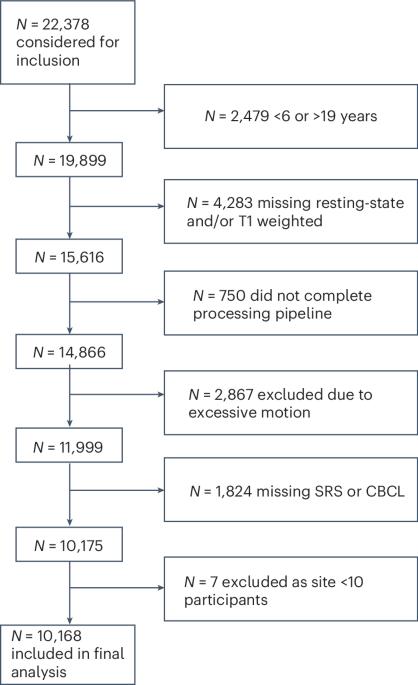Cross-sectional mega-analysis of resting-state alterations associated with autism and attention-deficit/hyperactivity disorder in children and adolescents
IF 8.7
引用次数: 0
Abstract
Autism spectrum disorder (autism) and attention-deficit/hyperactivity disorder (ADHD) often co-occur, although it remains unclear whether these conditions share common neurobiological foundations or exhibit distinct alterations in resting-state brain connectivity. Here we conducted a cross-sectional mega-analytic comparison of functional connectivity patterns linked to autism and ADHD traits in children and adolescents (ages 6–19 years; n = 10,168), with follow-up analyses considering autism (n = 764 autistic; n = 893 neurotypical) and ADHD (n = 2,026 ADHD; n = 2,409 neurotypical) diagnoses. In total, 12,732 unique child and adolescent participants were included: 3,528 in both analyses, 6,640 in the trait analysis only, and 2,564 in the diagnostic analysis only. Autism traits and diagnosis were associated with reduced connectivity between the thalamus, putamen, salience/ventral attention and frontoparietal networks, whereas ADHD traits showed the opposite pattern. Hyperconnectivity between the default mode and dorsal attention networks was observed in both autistic and ADHD groups relative to neurotypical individuals and associated with ADHD traits. Despite frequent co-occurrence, autism and ADHD traits exhibit distinct neural signatures, with small effect sizes indicating subtle associations. A comparison of functional connectivity patterns linked to autism and attention-deficit/hyperactivity disorder traits in children and adolescents reveals distinct patterns of brain connectivity despite frequent co-occurrence of these conditions.

儿童和青少年自闭症和注意缺陷/多动障碍相关静息状态改变的横断面大分析
自闭症谱系障碍(Autism spectrum disorder, Autism)和注意力缺陷/多动障碍(attention deficit/hyperactivity disorder, ADHD)经常同时发生,尽管目前尚不清楚这些疾病是否有共同的神经生物学基础,还是在静息状态下的大脑连接中表现出明显的改变。在这里,我们对儿童和青少年(6-19岁;n = 10,168)中与自闭症和ADHD特征相关的功能连接模式进行了横断面大分析比较,并对自闭症(n = 764名自闭症患者;n = 893名神经性患者)和ADHD (n = 2,026名ADHD患者;n = 2,409名神经性患者)诊断进行了随访分析。总共有12,732名独特的儿童和青少年参与者被包括在内:两种分析中有3,528人,仅特征分析中有6,640人,仅诊断分析中有2,564人。自闭症特征和诊断与丘脑、壳核、突出/腹侧注意力和额顶叶网络之间的连接减少有关,而ADHD特征则表现出相反的模式。在自闭症和ADHD组中,相对于神经正常个体,默认模式和背侧注意网络之间的超连接被观察到,并且与ADHD特征相关。尽管经常共存,自闭症和多动症的特征表现出明显的神经特征,小的效应量表明了微妙的联系。一项与儿童和青少年自闭症和注意缺陷/多动障碍特征相关的功能连接模式的比较揭示了不同的大脑连接模式,尽管这些情况经常共存。
本文章由计算机程序翻译,如有差异,请以英文原文为准。
求助全文
约1分钟内获得全文
求助全文

 求助内容:
求助内容: 应助结果提醒方式:
应助结果提醒方式:


